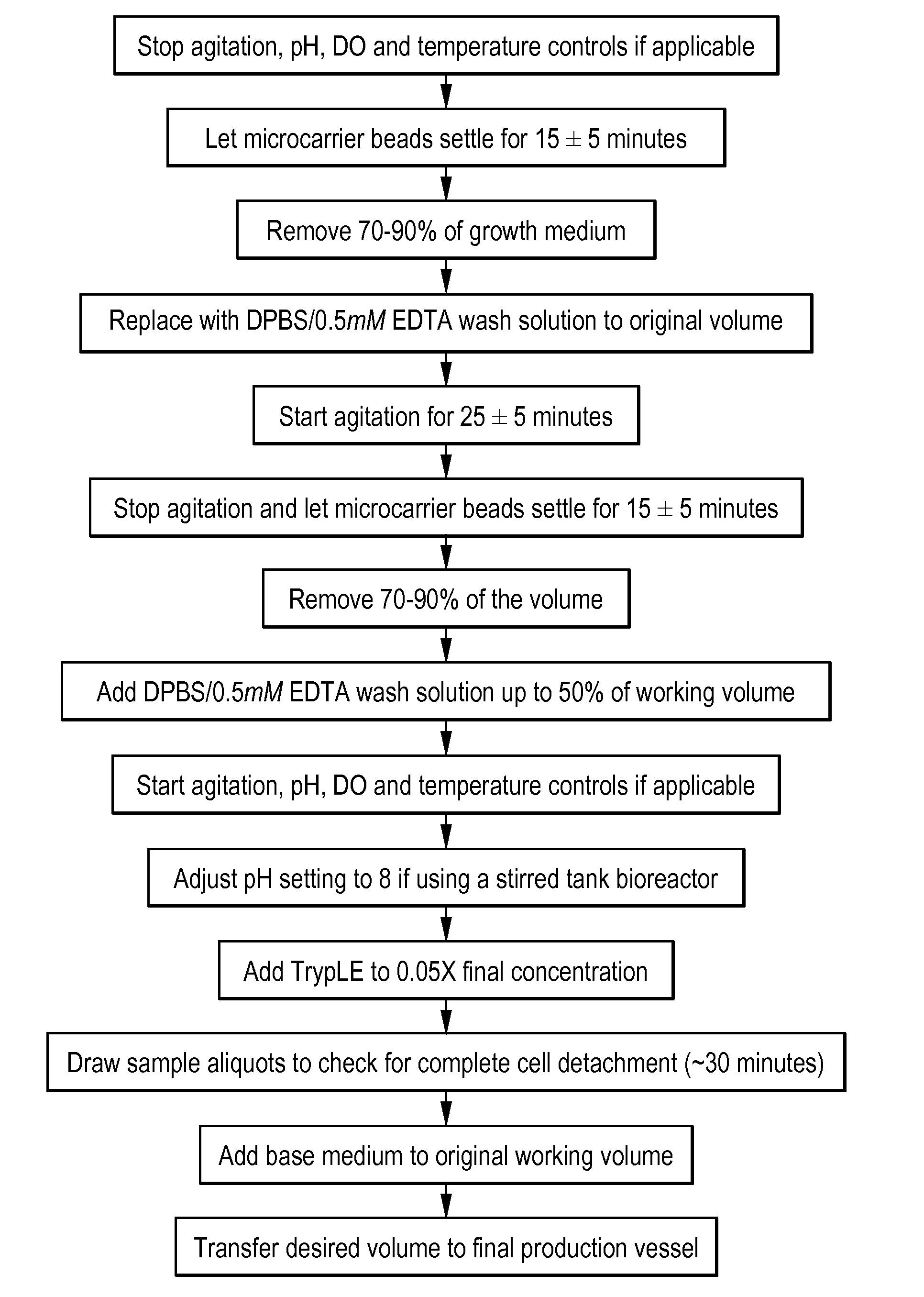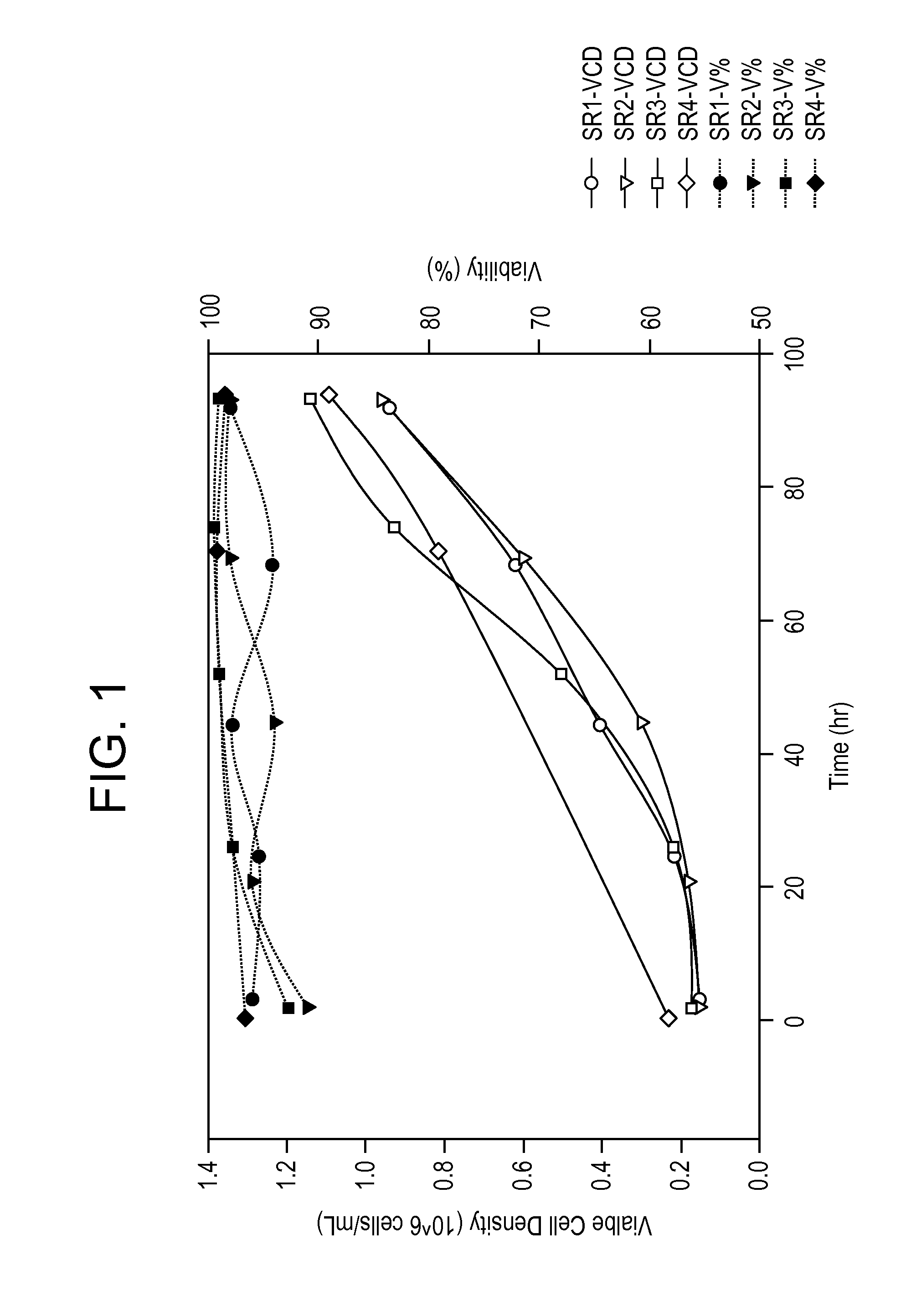Methods for purification of viruses
a technology of purification method and virus, applied in the field of cell-associated virus purification, can solve the problems of long lead time required to produce vaccines, many existing mdck cell lines suffer from one or more defects, and cannot be applied in the field of purification method
- Summary
- Abstract
- Description
- Claims
- Application Information
AI Technical Summary
Benefits of technology
Problems solved by technology
Method used
Image
Examples
example 1
Medium and Cell Culture Processes
[0261]Serum-free medium formulations (e.g., MediV SFM 107, MediV SFM 105) useful for the proliferation of MDCK cells, in particular non-tumorigenic MDCK cells, to high density have been described (see, e.g., FL410US and G-FL414US). However, work using these serum-free medium formulations with non-tumorigenic MDCK cells adapted to serum-free medium (e.g., ATCC Accession No. PTA-7909 or PTA-7910) revealed that, while reasonable peak viral titers (generally measured as log10 FFU / mL) of reassortant influenza virus could be obtained without medium exchange, the peak titers were still lower that those obtained with medium exchange, in which a portion (e.g., ˜67%) of the growth medium is removed and replaced with an infection medium after proliferation the cells and prior to (or at the same time as) infection. Furthermore additional protease (TrypLE) was required to obtain these peak titers. To overcome the need for medium exchange and / or the requirement fo...
example 3
Purification Process for Cell Culture Produced Influenza
[0357]The development of a robust large scale purification process for influenza produced in cell culture required intensive development. An early stage process was developed where the viral harvest (60-65 hours post infection) was pumped into a bag, and 10× sucrose phosphate (SP) buffer was added to the viral harvest (VH) bag at 1 / 10 (v / v) dilution for viral stabilization. The stabilized viral harvest (SVH) was first treated with Benzonase at 50 Units / mL with 2 mM MgCl2 at 32° C. for 3 hours to remove MDCK host cell DNA (HCD) and the reaction was stopped by addition of 5 mM EDTA. Benzonase is an engineered recombinant endonuclease that degrades DNA into oligonucleotides in the presence of magnesium ions. The Benzonase treated viral harvest was then clarified by a 1.2 μm Polypropylene (PP) and 0.45 μm PVDF capsule filters. The clarified VH was conditioned by 5-fold (5×) ultrafiltration and 5-fold diafiltration with SP buffer on...
example 4
Modified Purification Process for Cell Culture Produced Influenza
[0454]Additional modifications that can be made to the robust large scale purification process described in Section 8.3 are outlined in FIG. 10b and described in detail below. In particular, the harvest, clarification and TFF1 steps may be coupled to avoid the need for a harvest tank, reduce the number of manipulations and improve the overall processing time. For a smoother coupling operation TFF1 operation may be changed from constant TMP to constant Flux. Additionally, or alternatively, a lower TMP is utilized (lower than 20 psi, for example between about 10 psi (12,000 S−1) to about 14.5 psi (16,000 S−1)). A 2×UF step may added to the TFF2 step to decrease the bulk volume. Optionally, a 10XUF in used in TFF1 to potentially double the loading on all subsequent purification steps.
[0455]Table 26 summarizes the parameter changes, recovery, and HCD for several purification runs. These runs utilized virus produced in Medi...
PUM
| Property | Measurement | Unit |
|---|---|---|
| pore size | aaaaa | aaaaa |
| pore size | aaaaa | aaaaa |
| molecular weight cut off | aaaaa | aaaaa |
Abstract
Description
Claims
Application Information
 Login to View More
Login to View More - R&D
- Intellectual Property
- Life Sciences
- Materials
- Tech Scout
- Unparalleled Data Quality
- Higher Quality Content
- 60% Fewer Hallucinations
Browse by: Latest US Patents, China's latest patents, Technical Efficacy Thesaurus, Application Domain, Technology Topic, Popular Technical Reports.
© 2025 PatSnap. All rights reserved.Legal|Privacy policy|Modern Slavery Act Transparency Statement|Sitemap|About US| Contact US: help@patsnap.com



